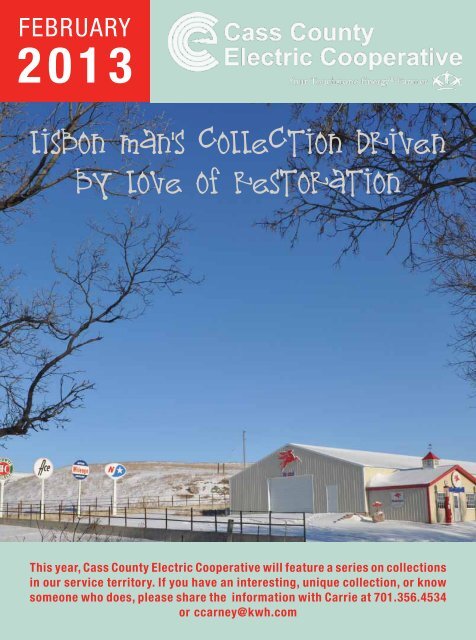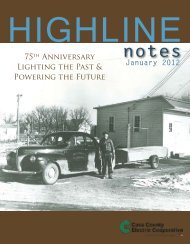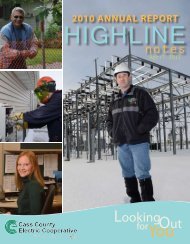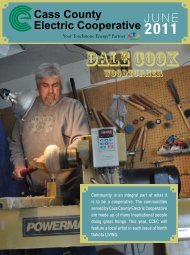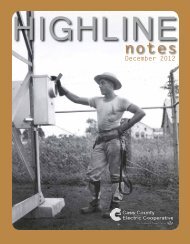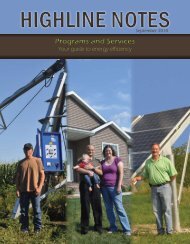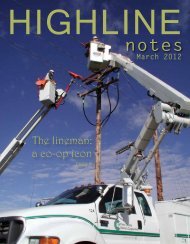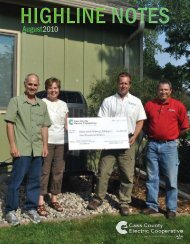Lisbon man's collection driven by love of restoration - Cass County ...
Lisbon man's collection driven by love of restoration - Cass County ...
Lisbon man's collection driven by love of restoration - Cass County ...
Create successful ePaper yourself
Turn your PDF publications into a flip-book with our unique Google optimized e-Paper software.
February<br />
2013<br />
<strong>Lisbon</strong> man’s <strong>collection</strong> <strong>driven</strong><br />
<strong>by</strong> <strong>love</strong> <strong>of</strong> <strong>restoration</strong><br />
This year, <strong>Cass</strong> <strong>County</strong> Electric Cooperative will feature a series on <strong>collection</strong>s<br />
in our service territory. If you have an interesting, unique <strong>collection</strong>, or know<br />
someone who does, please share the information with Carrie at 701.356.4534<br />
or ccarney@kwh.com
When approaching Charlie Jorgenson’s farm near <strong>Lisbon</strong>, it’s obvious<br />
he’s a collector. About 15 perfectly restored gas station signs stand<br />
intentionally alongside the neat outbuildings. The farmstead, where<br />
he was born, looks different than it did when other generations <strong>of</strong> his<br />
family farmed there. The barns are different as are the buildings that<br />
have popped up over the years and house the rest <strong>of</strong> his <strong>collection</strong>s.<br />
The <strong>collection</strong> began in the early 1990’s with Mobil memorabilia.<br />
Charlie and his son, Steve, both began collecting and it grew from<br />
there. Now, Charlie’s <strong>collection</strong> includes over 300 restored gas pumps<br />
from different eras, many restored cars from the ‘50s and ‘60s, and<br />
many signs. Each gas tank he’s restored has a miniature gas tank to<br />
go along with it. Charlie creates a miniature replica after he restores<br />
each tank.<br />
A couple <strong>of</strong> meaningful pieces in his <strong>collection</strong> are the 1927 car that<br />
was once <strong>driven</strong> <strong>by</strong> his grandfather and the gas wagon he restored.<br />
<strong>driven</strong><br />
<strong>love</strong> <strong>of</strong><br />
<strong>by</strong><br />
<strong>restoration</strong><br />
“It’s fun. You wouldn’t believe all<br />
the people we’ve met. We sell<br />
stuff overseas. We’ve had people<br />
from China here. Some were from<br />
South Africa that stayed about 10<br />
days. We’ve just met a lot <strong>of</strong> really<br />
fun people and without the hob<strong>by</strong> I<br />
would have never met any <strong>of</strong> them,”<br />
said Charlie.<br />
Pictures on opposite page, clockwise: Charlie Jorgenson and his wife<br />
stand near their favorite cars in the <strong>collection</strong>; ust a few <strong>of</strong> Charlie’s<br />
restored gas pumps; part <strong>of</strong> Charlie’s Mobil <strong>collection</strong>; model gas<br />
pumps; and a gas wagon Charlie restored.<br />
Between Charlie and Steve, they have about 1,500 cars total. Some<br />
are restored and some are lined up neatly in a near<strong>by</strong> field, waiting to<br />
be restored. Charlie has a <strong>collection</strong> that he keeps to himself, the rest<br />
are for sale.<br />
His son restores older cars and his grandson carries on the tradition<br />
through his own growing interest and says he’ll one day take over<br />
the restoring and collecting that his dad and grandfather do.“My<br />
grandson is only 10 and is really into it. Has his own 1957 truck,” said<br />
Charlie.<br />
Farming has always been Charlie’s career and he continues to farm<br />
with his son. In one outbuilding, he keeps all <strong>of</strong> the farm equipment<br />
he’s ever used since he started farming, although he doesn’t collect<br />
farm equipment beyond his own. He spends much <strong>of</strong> his downtime<br />
on his <strong>collection</strong> and never watches TV, claiming he wouldn’t even<br />
know how to turn it on.<br />
“Right now I’m restoring a ’57 Cameo pickup they only built about<br />
2200 <strong>of</strong> those,” said Charlie. “The hardest thing I’ve restored was<br />
the gas wagon. That was the most intricate with the wheels and the<br />
spokes, there was just so much stuff.”<br />
The gas pumps Charlie restores represent a worldly <strong>collection</strong>. He has<br />
French and Argentinean gas pumps, just to name a couple. Because<br />
he buys and sells a wide variety <strong>of</strong> items and parts, he is in contact<br />
with people all over the world.<br />
“It’s fun. You wouldn’t believe all the people we’ve met. We sell stuff<br />
overseas. We’ve had people from China here. Some were from South<br />
Africa that stayed about 10 days. We’ve just met a lot <strong>of</strong> really fun<br />
people and without the hob<strong>by</strong> I would have never met any <strong>of</strong> them,”<br />
said Charlie.
Getting Back<br />
On Line<br />
At CCEC we strive to provide you with the most reliable electric service. However, outages do occur and<br />
they are an unavoidable aspect <strong>of</strong> providing electricity. Therefore, we would like to illustrate the process <strong>of</strong><br />
how we restore your power during an outage. This article examines the repair process in one isolated area,<br />
but an important fact to remember is that with a typical outage, there are usually several areas affected at<br />
the same time. Consequently, this effort is occurring across our service area simultaneously.<br />
CCEC’s basic outage <strong>restoration</strong> principle: Priority goes to<br />
the lines that will get the most people back in service the quickest.<br />
<strong>Cass</strong> <strong>County</strong> Electric typically follows a basic principle when it comes to restoring power: priority goes to the lines that will<br />
get the most people back in service the quickest. This usually begins with main lines from the substations that can affect<br />
200-600 members, and continues out to tap lines, which may affect 30-200 members, and then to individual service lines<br />
affecting just 1-5 members.<br />
Step 1. Repairs start with the main line.<br />
Repairs start here.<br />
Energized power lines<br />
Un-energized power lines<br />
Location <strong>of</strong> damage<br />
The substation is energized but a main distribution line<br />
is damaged near the substation, leaving most members<br />
without power. First, all damaged tap lines need to be<br />
isolated from the main line and then repairs can begin<br />
on the main line from the substation. A large number <strong>of</strong><br />
members (shown with orange arrows) will have power<br />
returned once the main line is fixed. All other repairs would<br />
be pointless until this line is restored as it feeds all the<br />
other lines.<br />
Step 2. With the main line restored, the line crew can isolate other damage.<br />
With the main line restored (now<br />
shown in red), the line crew can<br />
isolate other damage and prioritize<br />
repairs. Though a couple <strong>of</strong> repairs<br />
were closer, fixing the line that<br />
serves this subdivision down the<br />
road will get a larger number <strong>of</strong><br />
consumers on more quickly.<br />
Energized power lines<br />
Un-energized power lines<br />
Location <strong>of</strong> damage<br />
One stop and an entire<br />
subdivision has power again.
Step 3. Tap lines serving the most members take precedence<br />
over those serving fewer members.<br />
Energized power lines<br />
Un-energized power lines<br />
Location <strong>of</strong> damage<br />
Moving back down the road to fix this tap line<br />
will restore electricity to the three homes marked<br />
with arrows.<br />
Back down the road, the crew makes one<br />
repair and restores power to this stretch <strong>of</strong> line.<br />
Next on the list for the line crew is a tap line serving<br />
two homes and a barn. The move probably doesn’t<br />
make the folks in the blue house too happy. They’ve<br />
seen the crew driving <strong>by</strong> their home and working<br />
right across the road. They see lights in the homes<br />
<strong>of</strong> all their neighbors but they don’t have power.<br />
That’s because even though electricity is coming<br />
to their pole (that happened with the first repair<br />
in Step 1), the service line from their pole to their<br />
meter is damaged. Individual repairs come after all<br />
distribution and tap lines are restored.<br />
Energized power lines<br />
Un-energized power lines<br />
Location <strong>of</strong> damage<br />
This repair restores power to<br />
these homes and farm.<br />
Step 4. Individual repairs are finished last.<br />
Energized power lines<br />
Un-energized power lines<br />
Location <strong>of</strong> damage<br />
Individual repairs begin once all other lines are repaired.<br />
Only after the tap lines are repaired does the<br />
crew start work on individual service lines.<br />
The crew could have stopped to restore<br />
power anytime after the first main line was<br />
repaired and electricity was flowing to the<br />
pole near<strong>by</strong>. But it is more efficient for the<br />
crews to move down the road and restore<br />
power to dozens <strong>of</strong> homes in the same<br />
amount <strong>of</strong> time.<br />
Outage Number:<br />
(701) 356-4499
Can an electric<br />
space heater save<br />
you money<br />
Some manufacturers claim that their electric space<br />
heater can significantly cut a home’s heating bill, but it’s<br />
important to understand how best to use them before<br />
accepting those claims.<br />
Most electric space heaters use between 600 – 1,500<br />
watts <strong>of</strong> electricity. If a homeowner were to use a space<br />
heater eight hours per day, five days per week for a<br />
month, it would cost about $26.<br />
Can space heaters cut your home heating bill Perhaps,<br />
but they simply can’t outperform efficient central heating<br />
or weatherization improvements.<br />
For example, an electric space heater produces one<br />
unit <strong>of</strong> heat for every one unit <strong>of</strong> electricity consumed,<br />
meaning they are 100 percent energy efficient. Space<br />
heaters that use natural gas are 80 percent efficient.<br />
Other factors also must be taken into consideration:<br />
• How much energy the space heater uses<br />
• How efficient the heating system is<br />
• How much the utility charges, for example, for natural<br />
gas and electricity<br />
Three main types are available, usually in a price range <strong>of</strong><br />
$30-$100. Before purchasing a space heater, you should<br />
determine how and where it will be used and which type<br />
will do the job best.<br />
Radiant heaters are intended to heat people – not the<br />
air – in a room. They are best used when the person can<br />
be directly in front <strong>of</strong> the heater, and they can be a good<br />
choice if you are in a room for a short period <strong>of</strong> time and<br />
want instant heat. They can pose a burn or fire risk and<br />
should not be placed near furniture, drapery, pets or small<br />
children.<br />
Convection heaters are designed to heat the air – not<br />
people. Hot air from the convection heater rises to the<br />
ceiling and forces cooler air to the floor. The cooler air is<br />
warmed and then rises to the ceiling, creating a cycle that<br />
continues as long as the heater is on. Convection heaters<br />
are warm to the touch and, compared to a radiant heater,<br />
have a decreased fire and burn risk.<br />
Combination heaters are radiant and convection heaters<br />
all in one package. They <strong>of</strong>ten have an internal fan that<br />
aids in distributing heat. They are versatile and more<br />
common, though they do not typically perform as well as<br />
a radiant or convection heater.<br />
Zone heating can cut costs. You can save money if you<br />
use the space heater with these tips in mind:<br />
Turn the thermostat <strong>of</strong> your central heating system down<br />
considerable (as low as 50 degrees in some cases).<br />
Place the space heater in a room that is occupied <strong>by</strong><br />
people, and close that room <strong>of</strong>f from the rest <strong>of</strong> the home.<br />
This method <strong>of</strong> “zone heating” will save money.<br />
Before purchasing a space heater, consider how the<br />
device is going to be used. While it may be technically<br />
possible to cut your heating bill, it is impractical and<br />
unrealistic for many.
Use electrical cords properly:<br />
Use heating correctly:<br />
• Avoid using damaged extension cords or<br />
running any cords through walls, under rugs<br />
or furniture, or across doorways.<br />
• Do not overload outlets or extension cords. If<br />
a cord feels warm, it could be a fire or shock<br />
hazard.<br />
• Never try to repair a damaged extension cord<br />
with electrical tape.<br />
• Never cut <strong>of</strong>f the ground pin to connect a<br />
3-prong appliance cord to a 2-wire extension<br />
cord or receptacle. Instead, use a national labcertified<br />
(CSA, UL, etc.) adapter.<br />
• Replace older extension cords if one <strong>of</strong> the<br />
prongs is not “polarized” (wider than the other).<br />
• Avoid placing cords where someone can<br />
accidentally pull them down or trip.<br />
• Cover unused outlets on the extension cord to<br />
prevent kids from getting a shock.<br />
• Before buying an extension cord, check that it’s<br />
lab-certified.<br />
• Outdoors, only use extension cords and<br />
appliances approved for such use.<br />
• Select the right cord. Larger appliances and<br />
power tools use cords with three prongs.<br />
• Make sure space heaters are in good repair and<br />
lab-certified (CSA, UL or ETL).<br />
• Do not use an extension cord to power a space<br />
heater. Make sure the circuit can handle<br />
the heater’s power demands and any other<br />
appliances plugged into it.<br />
• Keep space heaters three feet or more away<br />
from flammables (drapes, papers, upholstery),<br />
and out <strong>of</strong> reach <strong>of</strong> children and pets.<br />
• Never use heaters as drying racks.<br />
• Space heaters should have an automatic shut<strong>of</strong>f<br />
in the event they tip over.<br />
• If the heater runs on fuels like gas, kerosene<br />
or wood, follow manufacturer instructions<br />
carefully. Make sure carbon monoxide<br />
detectors are installed, and keep chimneys<br />
and flues free from corrosion or blockages.<br />
• Make sure electric blankets are undamaged. Do<br />
not put anything on top <strong>of</strong> it or tuck it under a<br />
mattress.<br />
Stay warm safely:<br />
• Space heaters and electric blankets can keep you cozy,<br />
but they can be fire and safety hazards, too.
NEWS<br />
Cooperative<br />
In December, over 2,000 new Two-Way<br />
Automatic Communications System (TWACS)<br />
meters were installed in Fargo. The installation<br />
project will continue over the next couple <strong>of</strong><br />
years until the system has been converted to<br />
TWACS meters.<br />
CCEC participated in the annual Holiday Lights<br />
Parade on November 20 with a new float this<br />
year promoting “We bring energy to life”.<br />
Employees donated gifts to FirstLink’s Giving<br />
Tree <strong>of</strong> Hope. Twenty-one gifts were collected<br />
and delivered to the event.<br />
Angie Hochhalter has been promoted to<br />
member account specialist. Angie started at<br />
CCEC in March as member care representative.<br />
Sarah Masseth has been hired as member care<br />
representative. Sarah recently graduated from<br />
Minnesota State Community and Technical<br />
College.<br />
Chris Erickson, power quality technician,<br />
completed training and has been certified as a<br />
Level I Infrared Thermographer.<br />
Visit us at the<br />
home & garden show<br />
February 22 - 24, Fargodome, Booth #780<br />
<strong>Cass</strong> <strong>County</strong> Electric Cooperative can help you save energy and money.<br />
Visit with us about energy saving ideas and products!<br />
HEADQUARTERS<br />
3312 42 nd St. S. Suite 200<br />
Fargo, N.D. 58104<br />
BOARD OF DIRECTORS<br />
Wendy Loucks, Chairman<br />
Russell Berg, Vice Chairman<br />
John Froelich, Secretary<br />
Sid Berg, Treasurer<br />
Douglas Anderson<br />
Robert Huether<br />
Marcy Svenningsen<br />
Steve Swiontek<br />
Jeff Triebold<br />
EXECUTIVE STAFF<br />
Scott Handy, President/CEO<br />
Brad Schmidt, Vice President <strong>of</strong> Engineering<br />
and Operations<br />
Chad Sapa, Vice President <strong>of</strong> Corporate<br />
Services/CFO<br />
Marshal Albright, Vice President <strong>of</strong> Member<br />
and Energy Services<br />
Tim Sanden, Vice President <strong>of</strong> Information<br />
Technology/CIO<br />
EDITOR<br />
Carrie Carney, ccarney@kwh.com<br />
DESIGNER<br />
Jocelyn Lura, jlura@kwh.com<br />
POWER CONTROL/<br />
SYSTEM MONITORING<br />
HOURS<br />
24 hours a day, 7 days a week, 365 days a<br />
year, our power control center monitors our<br />
system and handles outage situations. If<br />
you are a <strong>Cass</strong> <strong>County</strong> Electric member and<br />
encounter an emergency or power outage,<br />
please call (701) 356-4499 or (888) 277-4424.<br />
WEBSITE<br />
www.kwh.com<br />
EMAIL<br />
info@kwh.com<br />
BILLING QUESTIONS OR<br />
START/STOP SERVICE<br />
(701) 356-4430 or (888) 277-4422<br />
OTHER QUESTIONS<br />
701-356-4400 or 800-248-3292<br />
CALL BEFORE YOU DIG<br />
811 or 800-795-0555


